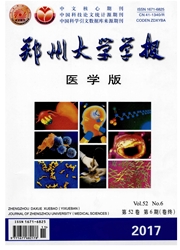

 中文摘要:
中文摘要:
目的:总结作者提出的新的重症肌无力(MG)临床分型和分期方法在外科治疗中的应用价值。方法:收集1998年1月至2007年12月收治的410例MG患者的病历资料,分3组,分别按作者提出的临床分型和分期方法(观察组,280例)、Osserman分型(对照1组,60例)和美国重症肌无力协会临床分型(对照2组,70例)进行术前分型,按所选分型方法指导手术适应证及时机的选择,均行胸腺(瘤)切除并前纵隔脂肪清扫术,比较术后肌无力危象的发生率以及手术死亡率,比较发生肌无力危象患者的术前分型和分期。结果:观察组术后危象的发生率为8.6%,对照1组为20.0%,对照2组为18.6%,与对照1、2组比较,观察组术后危象发生率明显降低(χ2=6.817和5.923,P均〈0.05)。观察组发作/进展期患者肌无力危象发生率为23.2%(22/95),远高于稳定/缓解期的1.1%(2/185),差异有统计学意义(χ2=39.037,P〈0.001)。3组患者手术死亡率均为0。结论:作者提出的MG临床分型和分期方法可指导手术适应证及时机的选择,有效降低术后肌无力危象的发生率。
 英文摘要:
英文摘要:
Aim:To explore the clinical significance of a new clinical classification and stages published by author in the surgery of the patients with myasthenia gravis.Methods:From January 1998 to December 2007,410 myasthenia gravis patients who received thymectomy were classified with different clinical classification,such as Osserman classification(control one group,60 cases),Myasthenia Gravis Foundation of Amercia(MGFA) clinical classification(control two group,70 cases) and a new clinical classification and stages published by author(observation group,280 cases).The differences among the three classifications were analyzed.The incidence of myasthenia crisis and mortality after thymectomy was also respectively studied.Results:The incidence of myasthenia crisis in observation group was 8.6%(24/280),it was significantly lower than that in control group one(20.0%,12/60) and two(18.6%,13/70).In observation group,the incidence of myasthenia crisis of the patients who were in attack/progress stage was significantly higher than those who were in stable/remissive stage(χ2=39.037,P0.001).The incidence of mortality was 0 in three groups.Conclusion:The incidence of myasthenia crisis can be decreased according to the new clinical classification and stages published by author.
 同期刊论文项目
同期刊论文项目
 同项目期刊论文
同项目期刊论文
 期刊信息
期刊信息
